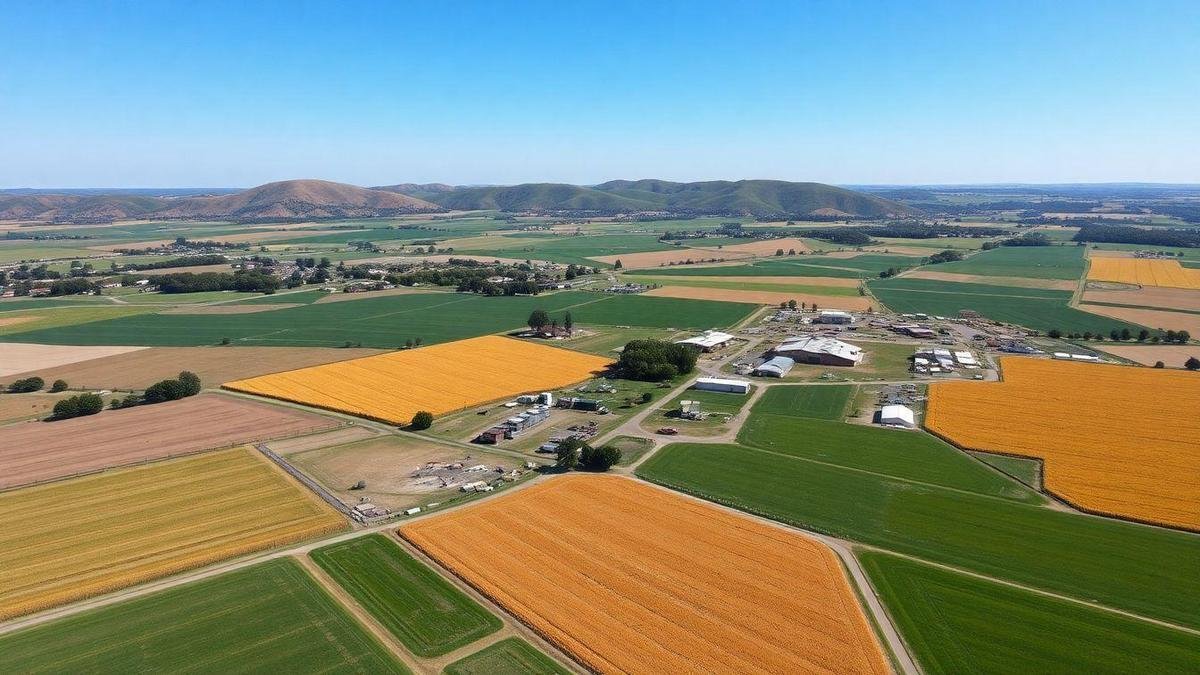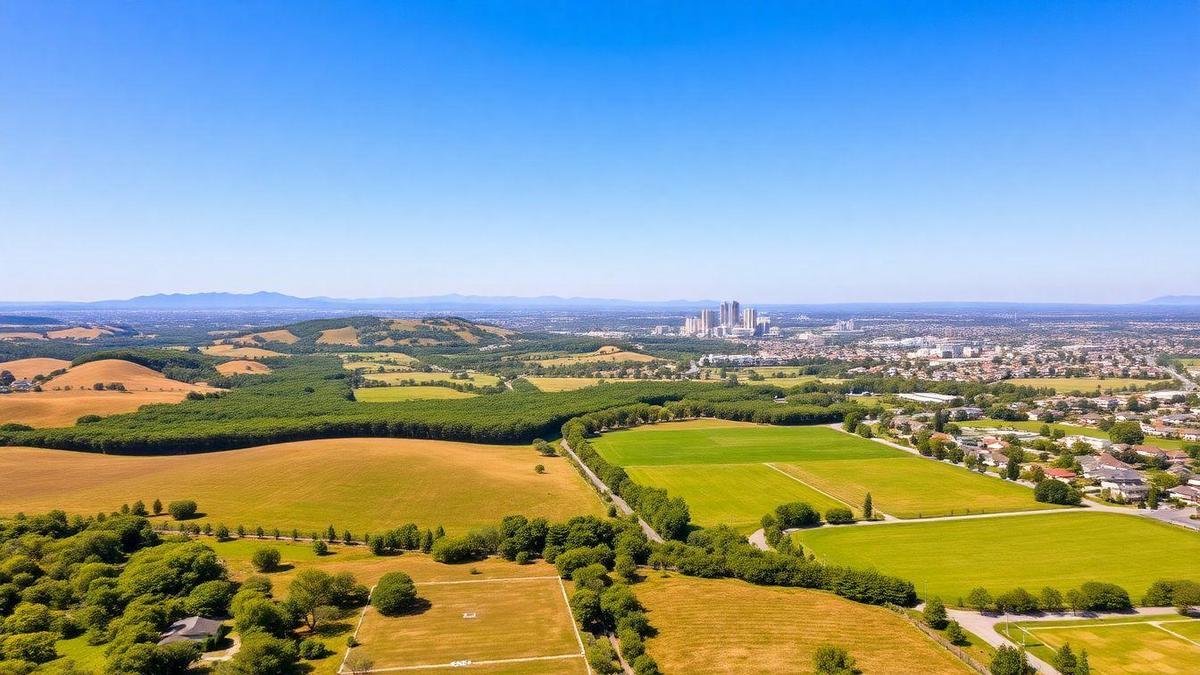When exploring the best states for land development, it is crucial to understand the many factors that influence this process. This article delves into key elements such as market analysis, economic indicators, and land opportunities in both urban and rural areas. By examining growth potential, investment strategies, and regulations, readers will gain valuable insights into making informed decisions in the land investment space.
Key Takeaways
- Many states offer great chances for land development.
- Look for areas with growing populations.
- Access to resources can boost land value.
- Good infrastructure helps development projects.
- Research local laws for land use before starting.

Overview of the Best States for Land Development
Key Factors Influencing Land Development
When considering the best states for land development, several factors play a crucial role. These include:
- Location: Proximity to urban centers can significantly affect land value.
- Zoning Laws: Understanding local zoning regulations is essential for development plans.
- Infrastructure: Access to roads, utilities, and public services can enhance land appeal.
- Market Demand: The need for residential, commercial, or industrial spaces drives development.
Each state has its own unique blend of these factors, making some more attractive than others for investors.
Importance of Market Analysis in Land Investment
Market analysis is vital for anyone looking to invest in land. This process helps investors identify trends and opportunities. By analyzing data, they can determine:
- Property Values: Understanding current market prices helps in making informed decisions.
- Future Growth: Predicting where the market is headed can lead to profitable investments.
- Competition: Knowing who else is investing in the area can help strategize effectively.
Investors who conduct thorough market analysis often find themselves ahead of the game. For a comprehensive guide on starting your journey in land development, you can explore how to start land development.
Understanding Economic Indicators for Investors
Economic indicators provide valuable insights for land investors. Key indicators include:
| Indicator | Description |
|---|---|
| GDP Growth Rate | Measures the economic health of a state. |
| Unemployment Rate | A lower rate often signals a strong job market. |
| Population Growth | An increasing population can drive demand for land. |
| Housing Starts | Indicates the number of new residential projects. |
These indicators help investors gauge the overall economic climate and make informed choices about land development.

Rural Land Investment Opportunities
Benefits of Investing in Rural Areas
Investing in rural areas offers several advantages that attract both seasoned investors and newcomers alike. One of the most compelling reasons is the lower cost of land compared to urban locations. This affordability allows for more extensive investments and potential for higher returns. Additionally, rural areas often have less competition, making it easier to acquire property.
Another significant benefit is the potential for growth. Many rural regions are experiencing an influx of people seeking a quieter lifestyle. This trend can lead to increased demand for housing and commercial spaces. Furthermore, rural land often comes with favorable zoning laws, allowing for diverse development options.
Popular Rural States for Land Development
When considering the best states for land development, certain regions stand out. Here’s a quick overview of some popular states:
| State | Key Features | Investment Potential |
|---|---|---|
| Texas | Large land areas, diverse economy | High (due to population growth) |
| Tennessee | Scenic landscapes, growing tourism | Moderate to High |
| Colorado | Outdoor recreation, tech growth | High (especially near cities) |
| Florida | Warm climate, retirement communities | High (due to migration) |
| North Carolina | Affordable land, strong agriculture | Moderate to High |
These states not only offer affordable land but also present opportunities for various developments, from residential to agricultural.
Analyzing Rural Land Market Trends
Understanding market trends is crucial for any investor. The rural land market is influenced by several factors, including economic conditions, population movements, and changes in local regulations.
- Population Growth: Areas with increasing populations often see a rise in land demand.
- Economic Development: States investing in infrastructure can boost land values.
- Interest Rates: Lower interest rates can make financing land purchases more attractive.
By keeping a close eye on these trends, investors can make informed decisions and capitalize on emerging opportunities.

Urban Land Growth Potential
Major Cities with High Growth Rates
Cities around the globe are expanding at a rapid pace. Major urban centers like Austin, Texas, and Nashville, Tennessee are experiencing some of the highest growth rates. Both cities have become magnets for new residents and businesses. Their vibrant economies and rich cultural scenes attract individuals and families alike.
| City | Growth Rate (%) | Key Industries |
|---|---|---|
| Austin, TX | 3.5% | Tech, Music, Education |
| Nashville, TN | 3.2% | Healthcare, Music, Tourism |
Other cities, such as Phoenix, Arizona, and Orlando, Florida, also show significant growth. These areas offer affordable housing and job opportunities, making them appealing to investors.
Factors Driving Urban Land Development
Several factors contribute to the demand for urban land. Population growth is at the forefront. As more people flock to cities, the need for housing and commercial spaces rises.
- Economic Opportunities: Cities with strong job markets attract individuals looking for work.
- Quality of Life: Access to amenities like parks, schools, and healthcare can sway people to move to urban areas.
- Technological Advancements: Innovations in construction and planning make urban development more efficient.

Land Use Regulations and Their Impact
Understanding Zoning Laws
Zoning laws play a crucial role in land development. They dictate how land can be used, whether for residential, commercial, or industrial purposes. These laws are set by local governments and vary from one area to another. For instance, a piece of land zoned for residential use cannot be transformed into a shopping mall without going through a complex process. This process often involves public hearings and approvals from various authorities. Understanding these zoning classifications is essential for investors looking to make informed decisions.
How Regulations Affect Development Opportunities
Regulations can either open the door to new opportunities or slam it shut. For example, strict environmental regulations may limit what can be built on a piece of land. Conversely, areas with relaxed regulations may offer more flexibility for development. Investors must be aware of these factors as they can significantly impact the potential return on investment.
Here’s a simple table to illustrate how different regulations can influence development opportunities:
| Regulation Type | Impact on Development |
|---|---|
| Environmental Laws | May restrict certain types of construction |
| Zoning Restrictions | Limits the type of businesses that can operate |
| Building Codes | Ensures safety but may increase costs |
| Permitting Processes | Lengthy processes can delay projects |

Best States for Agriculture and Land Development
States with Strong Agricultural Markets
When considering the best states for land development, certain regions stand out due to their thriving agricultural markets. These states not only have fertile land but also strong support systems for farmers and investors alike.
- California: Known for its diverse crops, California leads in agricultural production. From fruits to vegetables, it offers vast opportunities for investment.
- Iowa: Often called the heart of America’s corn production, Iowa has a robust agricultural sector. Its fertile soil and favorable climate make it a prime choice for land development.
- Texas: With its large expanse, Texas is not only famous for cattle ranching but also for cotton and more. The state’s agricultural market is booming, attracting investors from around the globe.
- Nebraska: This state is known for its rich farmland. Nebraska’s agricultural economy is strong, particularly in corn and beef production, making it a wise choice for land development.
Benefits of Agricultural Land Investment
Investing in agricultural land offers several advantages:
- Stable Returns: Agricultural land often provides consistent returns, even during economic downturns.
- Tax Benefits: Many states offer tax incentives for agricultural investments, making it financially appealing.
- Growing Demand: As the global population increases, the demand for food rises, ensuring that agricultural land remains valuable.
Trends in Agricultural Land Development
The landscape of agricultural land development is constantly changing. Recent trends highlight:
- Sustainable Practices: More investors are focusing on sustainable farming methods, which not only benefit the environment but also enhance land value.
- Technology Integration: The use of technology in farming, such as drones and precision agriculture, is becoming common. This trend is making farming more efficient and profitable.
- Urban Agriculture: As cities grow, urban farming is gaining traction. This trend allows investors to tap into local markets while promoting food security.
| State | Major Crop | Investment Potential |
|---|---|---|
| California | Fruits & Vegetables | High |
| Iowa | Corn | Moderate |
| Texas | Cattle & Cotton | High |
| Nebraska | Corn & Beef | Moderate |

Property Development Trends in 2023
Current Trends Shaping the Land Market
In 2023, the land market is witnessing several impactful trends. One major trend is the increased demand for sustainable developments. Investors are now prioritizing eco-friendly projects that reduce environmental footprints. Additionally, urbanization continues to surge, with cities expanding rapidly as more people seek housing and amenities. This shift is prompting developers to focus on mixed-use properties that combine residential, commercial, and recreational spaces.
Another noteworthy trend is the rise of technology in property development. Innovations such as smart homes and automated building management systems are becoming standard. These advancements not only enhance living experiences but also attract tech-savvy buyers. Furthermore, the remote work culture is influencing land use, as many individuals prefer homes in suburban areas that offer larger spaces and a quieter environment.
Predictions for Future Development Opportunities
Looking ahead, several predictions can be made about the land development landscape. The demand for affordable housing will likely increase, especially in metropolitan areas where prices are skyrocketing. Developers who can provide cost-effective options will find themselves in a prime position.
Additionally, the shift towards renewable energy will create opportunities for projects that incorporate solar panels and other green technologies. As governments push for cleaner energy, investors who align with these initiatives are expected to reap rewards.
| Future Development Opportunities | Potential Impact |
|---|---|
| Affordable Housing | Increased market demand |
| Renewable Energy Projects | Government incentives and support |
| Smart Technology Integration | Attraction of tech-savvy buyers |
How Trends Affect Investment Decisions
These trends significantly influence how investors approach the land market. With sustainability at the forefront, they are more inclined to invest in projects that promise long-term environmental benefits. This shift not only aligns with personal values but also appeals to a growing segment of buyers.
Moreover, the rise of technology in development leads investors to seek properties that offer smart features. Properties equipped with the latest tech are often seen as more valuable and marketable.
In summary, understanding these trends is crucial for investors aiming to make informed decisions. By staying ahead of the curve, they can identify the best states for land development and capitalize on emerging opportunities.

Investment in Undeveloped Land
Why Undeveloped Land is Attractive
Investing in undeveloped land can be a smart move for many investors. One major reason is the potential for appreciation. As cities grow and expand, raw land can increase significantly in value. Investors often find that buying land in areas set for development can yield high returns.
Another appealing aspect is the flexibility that comes with undeveloped land. Investors can choose how to use it, whether for residential, commercial, or agricultural purposes. This versatility allows them to tailor their investments to meet market demands.
Risks and Rewards of Investing in Raw Land
Investing in raw land does come with its own set of risks. One of the biggest challenges is that undeveloped land may not generate any immediate income. Investors must be patient and prepared for a long-term commitment. Additionally, zoning laws and environmental regulations can complicate development plans.
However, the rewards can be significant. For instance, land in growing areas can appreciate rapidly. Investors who do their homework and understand local markets may find themselves sitting on a goldmine.
| Risks | Rewards |
|---|---|
| No immediate income | Potential for high appreciation |
| Zoning challenges | Flexibility in use |
| Market fluctuations | Long-term investment potential |
Strategies for Successful Undeveloped Land Investment
To navigate the complexities of investing in undeveloped land, investors should adopt certain strategies. First, research is crucial. Understanding the local market and its trends can help investors make informed decisions.
Next, investors should consider diversifying their land portfolio. This means not putting all their eggs in one basket. By investing in different locations or types of land, they can spread out their risk.
Lastly, networking with local real estate professionals can provide valuable insights. These connections can lead to opportunities and help investors stay updated on market changes.

Top States for Real Estate Investment
Comparing Real Estate Markets Across States
Investors looking for the best states for land development often find themselves comparing various real estate markets. Each state offers different opportunities and challenges. For instance, states like Texas and Florida are known for their booming populations and strong job markets. In contrast, states like California have high property values but also face significant regulatory hurdles.
| State | Population Growth | Average Home Price | Job Market Strength |
|---|---|---|---|
| Texas | High | Moderate | Strong |
| Florida | High | Moderate | Strong |
| California | Moderate | High | Variable |
| New York | Low | High | Strong |
This table illustrates key metrics that can help investors assess where to focus their efforts. Texas stands out with its favorable business climate, while Florida attracts many retirees and families seeking a warm climate.
Factors to Consider When Choosing a State
When selecting a state for real estate investment, several factors come into play. Economic stability, population trends, and local regulations are paramount. Investors should consider:
- Market Trends: Understanding whether the market is appreciating or depreciating.
- Regulatory Environment: Some states have more investor-friendly laws.
- Infrastructure Development: States with ongoing infrastructure projects often see property values rise.
These elements can significantly impact the potential return on investment.
Evaluating Real Estate Investment Risks
Investing in real estate is not without risks. Factors such as economic downturns, natural disasters, and market fluctuations can affect property values. Investors should conduct thorough research to identify potential risks associated with their chosen state.
For example, states prone to hurricanes may pose a higher risk for property damage, impacting long-term investment viability.

The Importance of Land Market Analysis
Tools for Effective Market Analysis
Land market analysis is crucial for investors aiming to make sound decisions. Various tools aid in this process. Some of the most effective include:
- GIS Software: Geographic Information Systems (GIS) allow investors to visualize land data, such as zoning and land use.
- Market Reports: These provide insights into trends, pricing, and demand in specific areas.
- Online Platforms: Websites like Zillow and Realtor.com offer real-time data on land listings and sales.
Using these tools, investors can gather valuable information that helps them make informed choices. For a detailed exploration of land development resources, consider visiting Land Dev Hub.
How to Analyze Local Land Markets
Analyzing local land markets requires a systematic approach. Investors should follow these steps:
- Research Local Trends: Look into recent sales and listings in the area.
- Evaluate Zoning Regulations: Understanding zoning laws is key to determining what can be built on a property.
- Assess Infrastructure: Check for nearby amenities like schools, hospitals, and transportation options.
By focusing on these aspects, investors can gain a clearer picture of the market landscape.
Making Informed Decisions Through Market Data
Data plays a vital role in decision-making. When investors gather and analyze market data, they can:
- Identify opportunities in emerging areas.
- Predict future trends based on historical data.
- Avoid poor investments by understanding market fluctuations.
This data-driven approach helps investors navigate the complexities of land development, leading to more successful outcomes.
In the end…
In conclusion, navigating the land development landscape requires a keen understanding of various factors that influence investment opportunities. From market analysis to zoning laws and economic indicators, each element plays a pivotal role in shaping the potential for growth in both urban and rural areas. Investors must stay vigilant and conduct thorough research to identify the best states for land development, ensuring that they are well-equipped to seize emerging opportunities. As the market evolves, being proactive and adaptable will be crucial for success. For further insights and resources on land development, readers are encouraged to explore more articles at Land Development Hub.

2 Responses
[…] a State: Selecting the right state is crucial. Some states, like Delaware and Wyoming, are popular for their business-friendly […]
[…] Investors should research location trends carefully, particularly in popular states for land development. […]